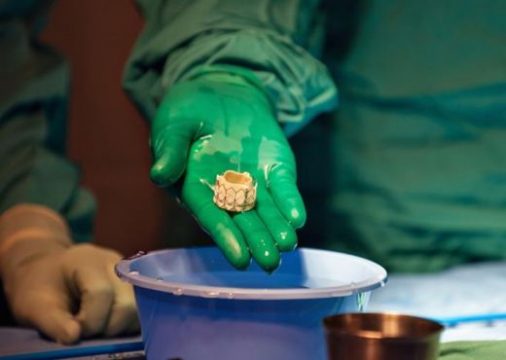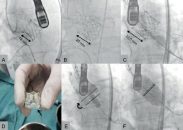Original Title: Utilization and 1-Year Mortality for Transcatheter Aortic Valve Replacement and Surgical Aortic Valve Replacement in New York Patients With Aortic Stenosis2011 to 2012. Reference:Hannan EL et al. J Am CollCardiolIntv. 2016;9(6):578-585. Courtesy of Dr. Agustín Vecchia It’s been only 14 years sinceCribierperformed the first transcatheter valve replacement. Today, during 2016, 100,000 patients are expected to…
PARTNER 2A: TAVI Not Inferior to Surgery in Intermediate Risk Patients
Transcatheter aortic valve replacement (TAVI) with the new generation balloon expandable valve is at least as good as surgery in intermediate risk patients with severe symptomatic aortic stenosis. For those that can be accessedfemorally, TAVI seems even better than surgery. In all, 2032 intermediate risk patients were randomized in 57 centers to TAVI with Sapien…
The SAPIEN 3 Valve Resulted Superior to Surgery in an Observational Study
The last generation of the balloon expandable valve resulted superior to surgery in intermediate riskpatients, in a registry analyzis. Patients treated with the SAPIEN 3 valve showed lower rates of death, stroke and paravalvular leak at one year than patients undergoing surgery. This third generation improves the SAPIEN XT with a skirt designed to prevent…
CoreValve US Pivotal: at 3 Years, the Self-Expanding Valve Maintains Its Advantage vs. Surgery
At 3 year follow up, the CoreValve US Pivotal study on high risk elderly patients, the self-expanding valve showed a lasting benefit vs. surgery. These findings could suggest that the self-expanding valve should be considered the preferred treatment in patients with symptomatic severe aortic stenosis at increased risk for surgery. The study included 797 patients…
PARTNER 1 in +90 Year Old Patients: TAVI and the Age Paradox
A new analyzis of the PARTNER 1 trial showed that patients over 90 undergoing transcatheter aortic valve replacement (TAVI) show no increase in mortality or major cardiovascular events rates, compared to younger patients. In fact, patients over 90 undergoing TAVI have the same life expectation of someone the same age with no aortic stenosis. In-hospital…
Less Paravalvular Regurgitation and More Pacemakers for the New Balloon Expandable Valve
Original Title: Changes in the Pacemaker Rate After Transition from Edwards SAPIEN XT to SAPIEN 3 Transcatheter Aortic Valve Implantation. The Critical Role of Valve Implantation Height. Reference: Fernando De Torres-Alba et al. J Am CollCardiolIntv. 2016, online before print. The aim of this study was to analyze pacemaker implantation rates with the new generation…
TAVR-LM Registry: Transcatheter Aortic Valve Replacement and Left Main Stenting
Original Title: Outcomes in Patients with Transcatheter Aortic Valve Replacement and Left Main Stenting. The TAVR-LM Registry. Reference: TarunChakravarty et al. Journal of the American College of Cardiology, Vol 67, N° 8, 2016. Courtesy of Dr. Santiago F. Coroleu. High surgical risk patients with severe aortic stenosis and significant left main aortic arterydiseaseare often treated combining…
The largest series with LOTUS Valve published so far
This work represents the UK experience with the second generation repositionable and retrievable valve Lotus (Boston Scientific, Natick, Massachusetts). It prospectively included 228 patients of mean age 81.4 ± 7.6 and a logistic EuroScore of 17.5 ± 12.4. From the total number of patients, 187 (82%) received the valve for aortic stenosis, 7…
Atrial Fibrillation: Important Impact on TAVI
Original Title: Atrial Fibrillation Is Associated With Increased Mortality in Patients Undergoing Transcatheter Aortic Valve Replacement: Insights From the Placement of Aortic Transcatheter Valve (PARTNER) Trial. Reference: Angelo B. Biviano et al. Circ Cardiovasc Interv. 2016 Jan;9(1):e002766. Courtesy of Dr. Carlos Fava. The conversion to atrial fibrillation (AF) in the context of transcatheter aortic valve replacement…
Comparing Computed Tomography vs. Angiography to Assess Transfemoral Access for TAVI
Original Title: Transfemoral Access Assessment for Transcatheter Aortic Valve Replacement Evidence Based Application of Computed Tomography over Invasive Angiography. Reference: Circ Cardiovas Imaging 2015 DOI:10.1161/CIRCIMAGING.114.0011995. Courtesy of Dr. Guillermo Migliaro Transfemoral access for TAVI was introduced in 2006 and is considered first choice. Vascular complications (VCs) are important events that correlate to increased mortality. According to the…





